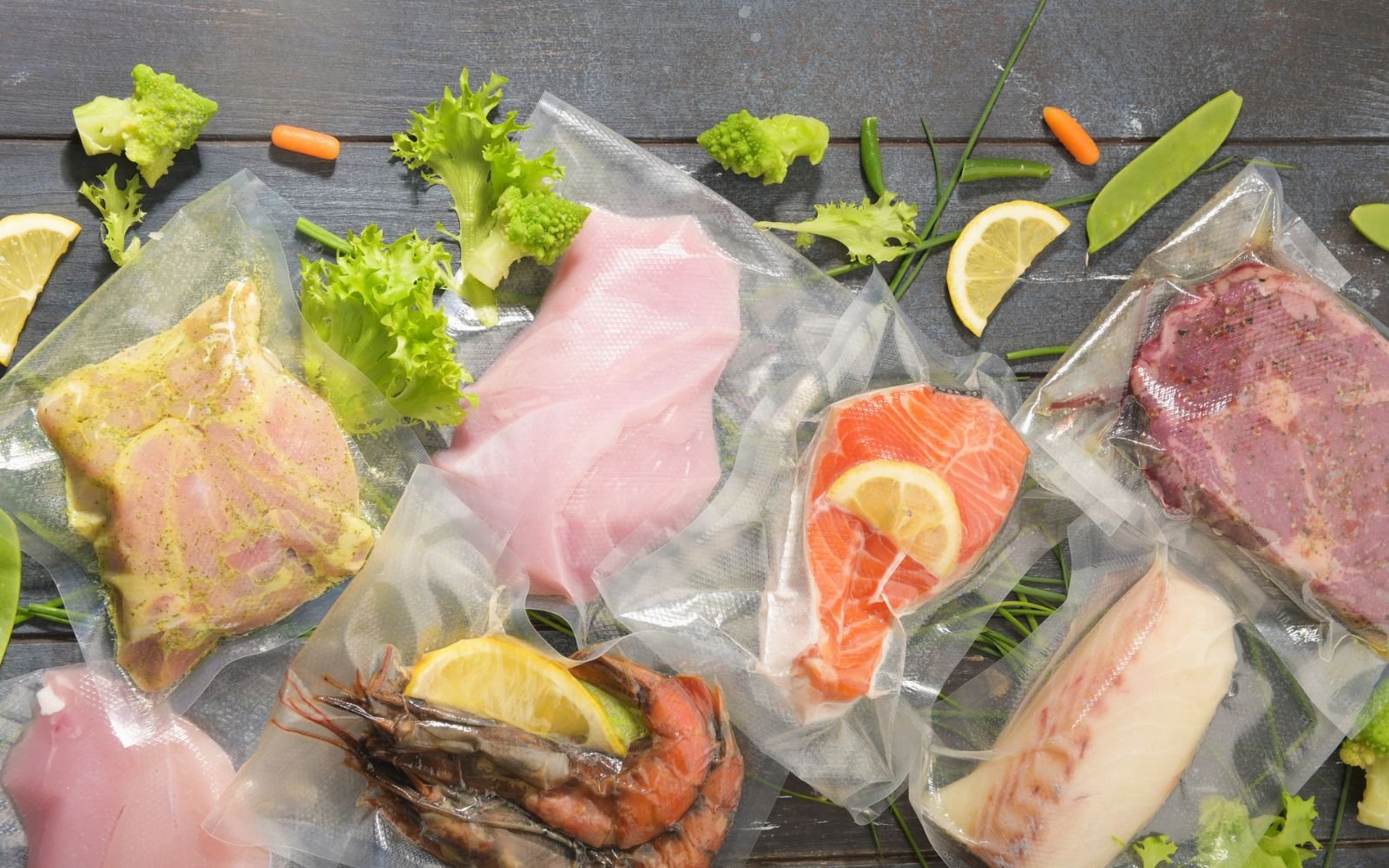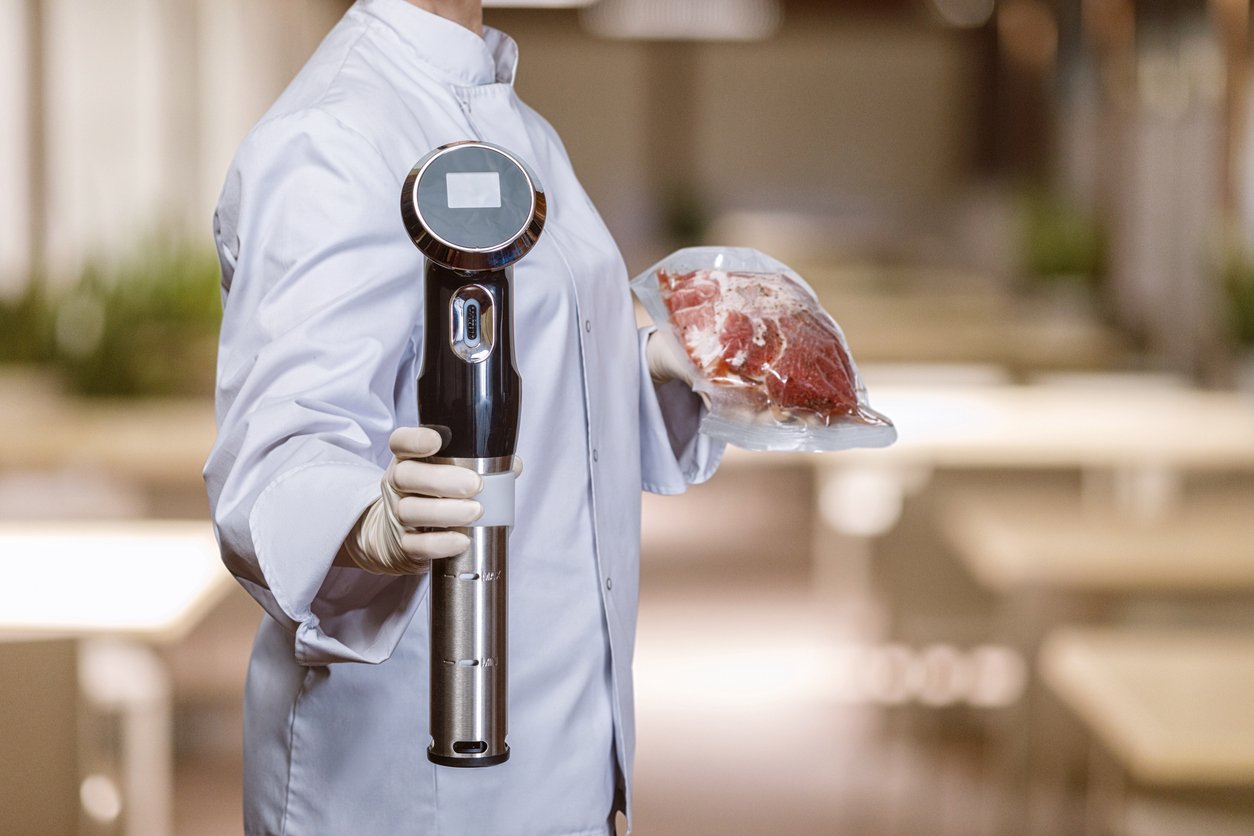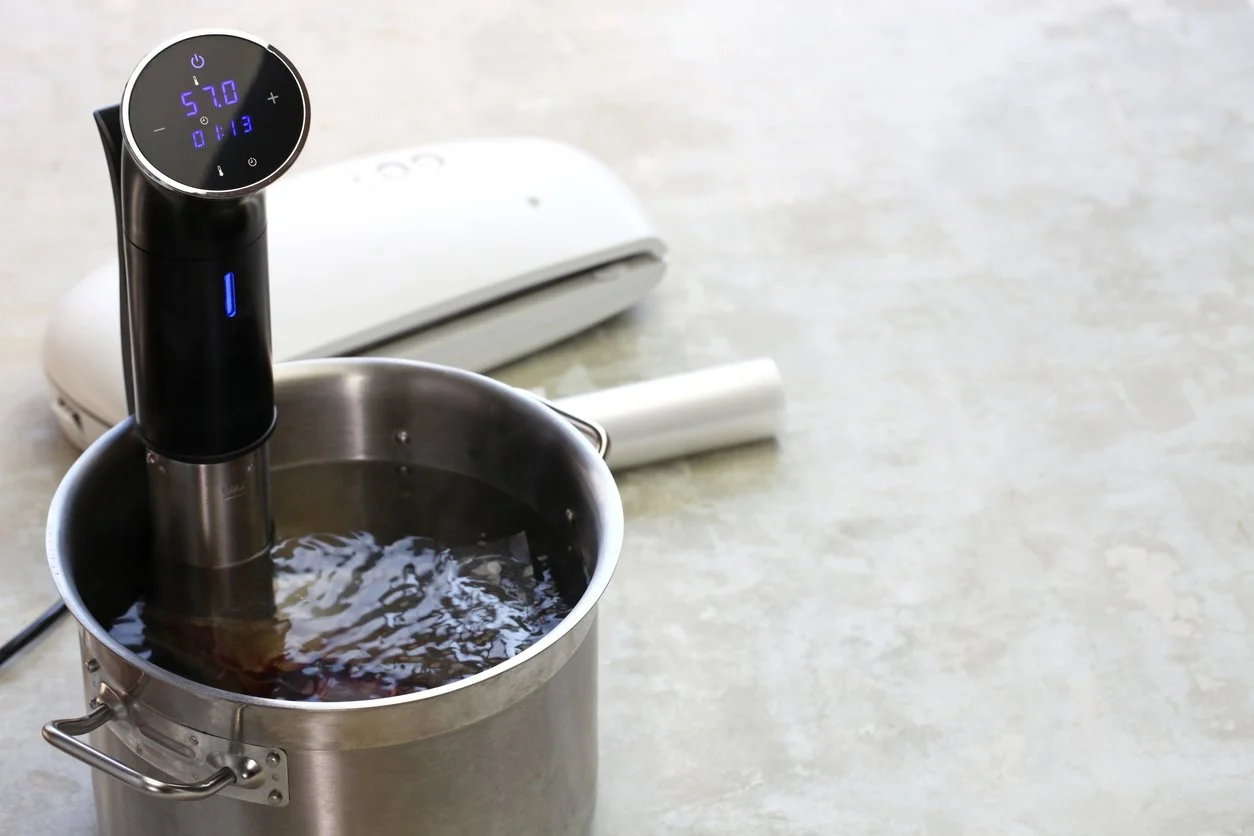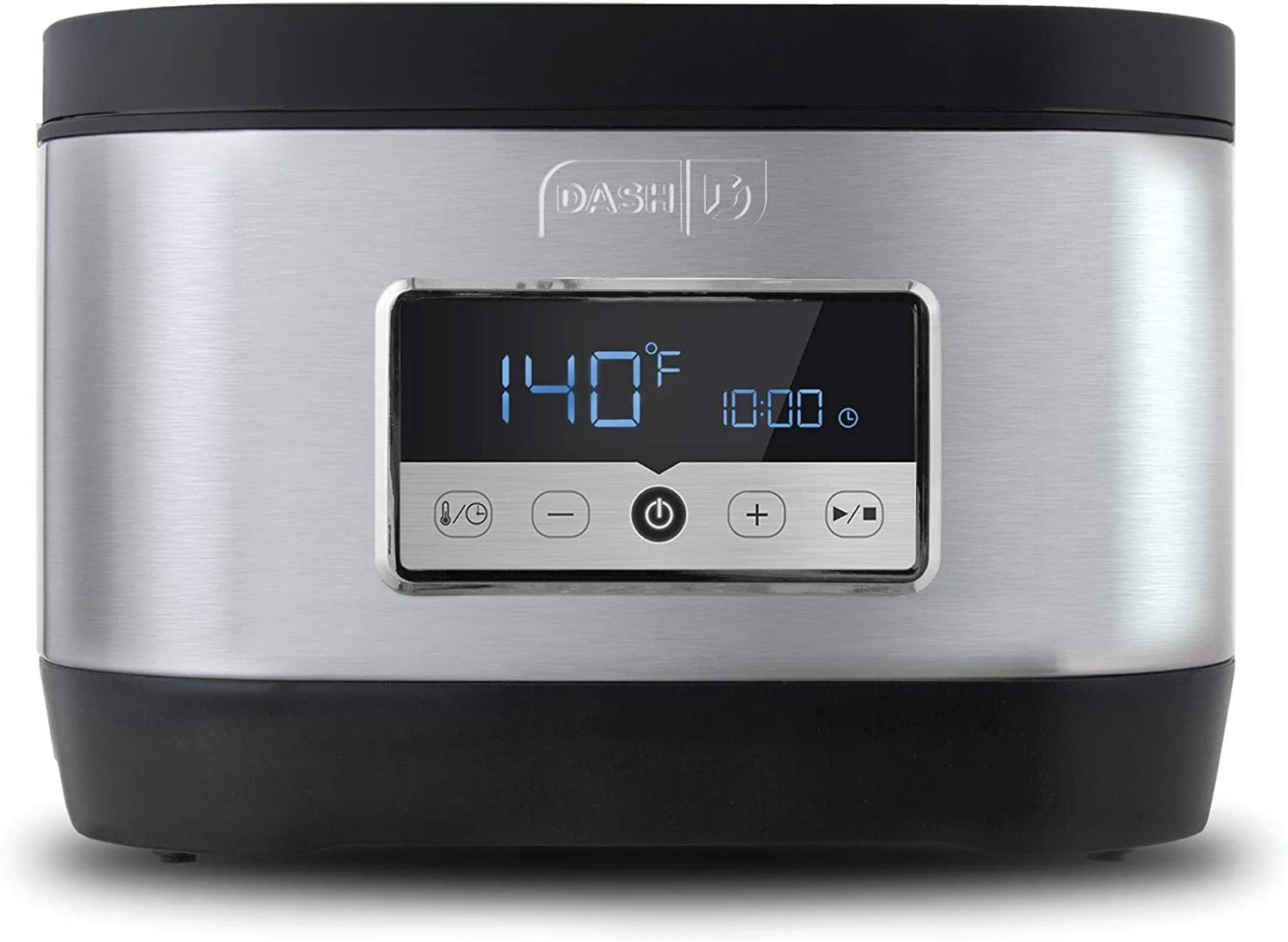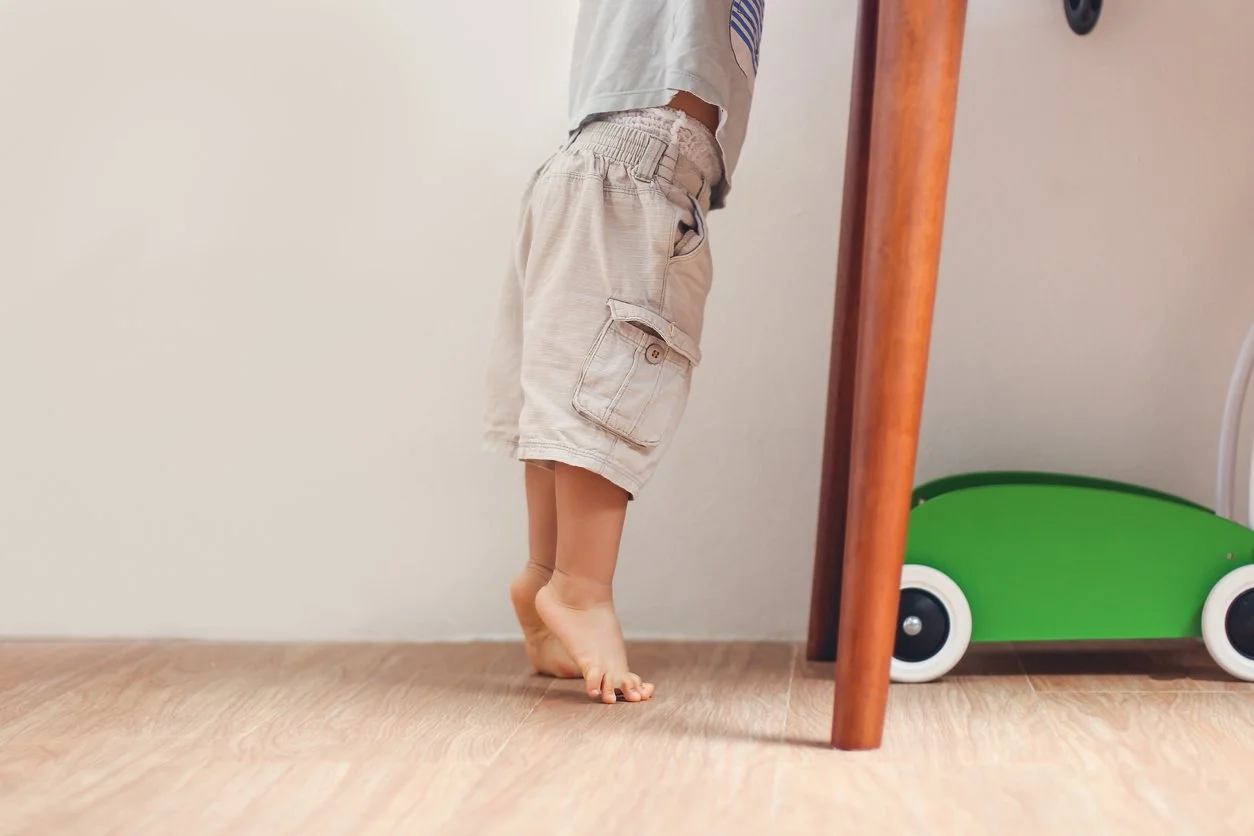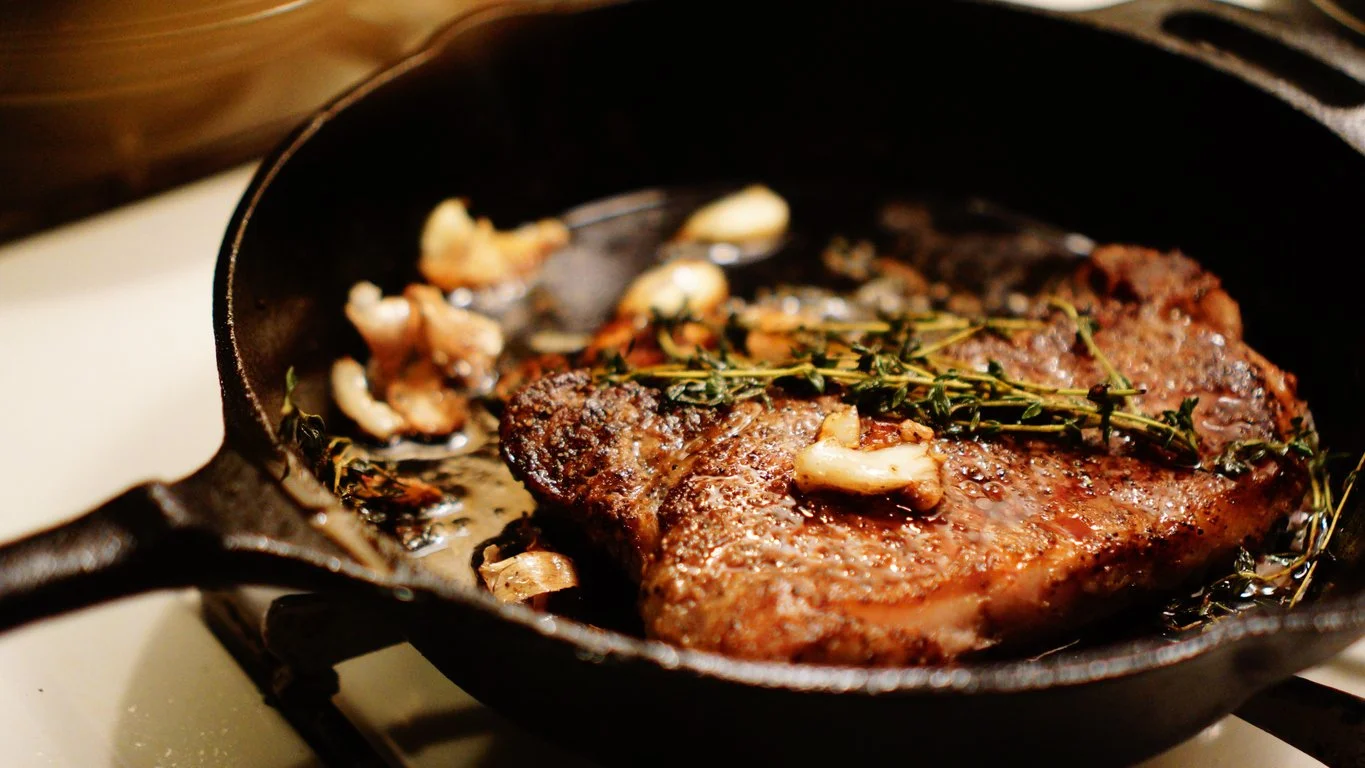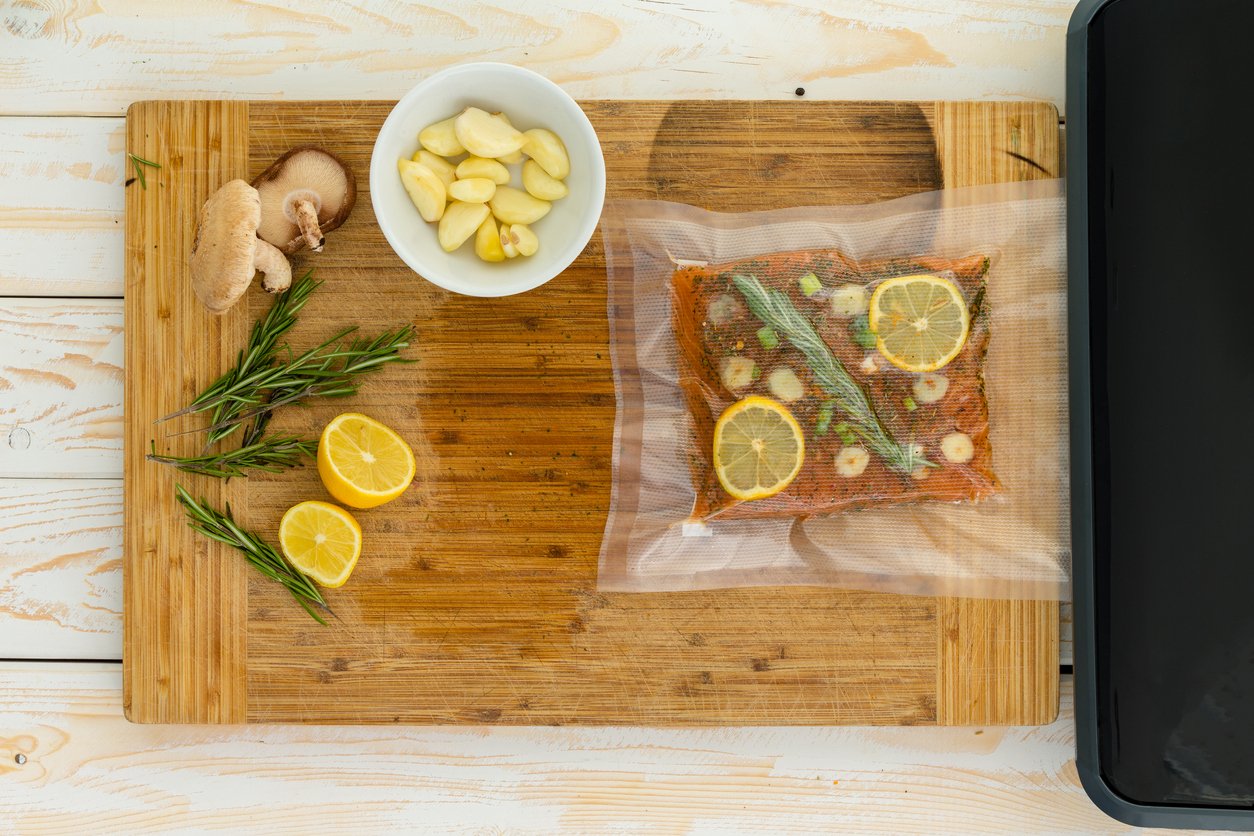Everything You Need to Know About Sous Vide, and More
Discover > Texas Home Cooking > Everything You Need to Know About Sous Vide, and More
What is sous vide? Sous vide, pronounced as sue-veed is a French term for “under vacuum.” It is described as a method of cooking in which food is sealed in a vacuum-sealed bag and then cooked in a water bath at a precise and consistent temperature.
The sous vide method became very popular in Texas with many restaurants across the state using sous vide machines or immersion calculators to churn out tender and flavorful sous vide-cooked food. This method of cooking allows the food to retain its natural flavors and nutrients while being cooked gently and evenly.
It is popular among busy restaurant chefs as it eliminates the need to constantly monitor the food during the cooking process. And with the recent wave of affordable immersion circulators, this cooking method is becoming more and more popular for home cooks as well.
Keep reading to know how to sous vide safely. But first, let’s talk about its history.
History of Sous Vide Cooking
The Sous vide cooking method was first developed in the 1970s by two French men; chef George Pralus and Dr. Bruno Goussault. Back then they were trying to find a way to keep heat and oxygen away from their food. Heat and Oxygen diminish the food flavors. For his part Dr. Goussault used a Julabo laboratory thermometer to precisely keep the temperature limits for optimal cooking.
On the other hand George Pralus was looking for a way to cook steak that would retain its juices and flavors while being cooked evenly throughout. In 1974 he discovered that wrapping Foie Gras in plastic prevented the liver from shrinking as it cooked. Pralus who is recognized as the father of Sous Vide along with Dr. Goussault teamed up with plastic manufacturer Cryovac to refine the method which we now know today as Sous vide.
Pralus would use this cooking method to cook his steaks. Eventually it spread to Texas in the 2000s. It is not surprising considering that Texans take their steak seriously. From a few restaurants offering Sous vide cooked steak on their menus it has become popular across the state. Some restaurants even incorporate liquid smoke as a flavor additive into Sous vide to recreate that smokey BBQ flavor.
Sous Vide Equipment & Tools You'll Need
If you are going into Sous Vide cooking, there are several equipment and tools that you will need.
The most basic equipment is having a Sous Vide machine. These can be water ovens or immersion calculators. A Sous Vide machine is used to heat your food to the right temperature while keeping juices and flavors intact.
One of the most popular Sous vide machines is an immersion calculator. Immersion circulators keep the water moving and the target cooking temperature constant throughout the cooking process.
Flavors are influenced by time, temperature, ingredients and type of immersion. This tool allows you to adjust these factors to get the desired flavor.
I am recommending Anova Culinary AN500-US00 Sous Vide Precision Cooker which is the best-selling immersion calculator on Amazon. You can cook like a professional with this wifi capable device as it ensures perfect cooking results every time you are using it. One feature I really like is the Anova app where I can access thousands of recipes. I can also monitor the sous vide process anywhere through my smartphone.
Another Amazon recommended immersion calculator is the Inkbird WiFi Sous Vide Precision cooker. It rates high in value for money and for its user-friendly features.
An alternative to immersion calculators are sous vide water ovens. Also known as countertop water baths, which looks like a microwave oven. They have a built-in water bath as compared to an immersion calculator which would need another water container or cooking vessel.
Water Oven vs. Immersion Calculators
If you are thinking of what to buy for your sous vide cooking, would it be an immersion calculator or a countertop water bath, here are some considerations when making that shopping decision.
Function- Both devices can heat up water up to the precise temperature needed for cooking. However, the water oven does not circulate water and would not ensure even temperature as compared to immersion calculator. However they are better at providing insulation as water oven comes with a lid to prevent water from evaporating.
Size- Water ovens are equivalent to microwaves. If your kitchen is small, perhaps you would need smaller devices such as immersion calculator
Price- Water ovens have a much higher price range than immersion calculators.
A popular water oven brand sold at Amazon is the Dash Chef water oven. It is easy-to-use and a reliable machine for those wanting to go sous vide in their homes.
Containers and Bags
Another essential piece of tool you need is a food-safe resealable bag. I recommend heavy-duty BPA free bags. I am using ziplock bags in my Sous vide. Though having vacuum-sealed bags is recommended for nice sous vide cooking. A resealable bag will do. To recreate the vacuum effect during cooking, you can do a water displacement technique
Water Displacement Technique
Place food in a zipper style freezer bag
Seal bag, leave last bit unsealed to let the air escape. Submerge the bag in water. Massage the bag around the food to let the air escape.
When food is submerged seal the bag to let it cook.
In this technique, the pressure of the water forces air to go out into the top of the bag. Once most of the air has escaped you would seal it just adobe the water line.
The third essential Sous Vide item is a container to hold the water. The container must have a minimum water depth of 2.5 inches or 6.35 centimeters. Do not use a water container shallower than the specification. Also the container must be food grade and would not leach chemicals into the food. Buy a food container specifically used for Sous vide. The most popular cooking vessel for sous vide are made from polycarbonate. They're tough and see-through so you can monitor your cook at a glance.
A popular water container brand is the Anova ANTC01 Sous Vide Cooking Container which can handle 16 L of water, it is designed for sous vide as its curved body encourages better water circulation. It is sold at Amazon for $99.
Now you have the right equipment, you are ready to cook Sous vide.
How Sous Vide Works
The Sous vide style of cooking became popular due to the low temperature that ensures even cooking and breaks down many of the tough components of meat without overcooking the rest. This makes dishes such as steaks, chicken breasts (What wine goes well with chicken breast?) and pork chops (What wine goes well with pork chops?) a sure-fire winner among customers hence it became a widely-used cooking method among restaurants particularly here in the meat loving state of Texas. Can you imagine a steak cooked perfectly medium rare all through? or Chicken breasts that are as moist and as juicy as thighs? Yep, you heard that right, chicken breasts as moist as thighs when cooked sous vide style!
Sure Sous Vide looks easy, you just vacuum seal your ingredients, put it on a water container, selecting a cooking time and the right temperature and you’d just wait for it to cook. There is actually a lot of science involved in Sous Vide.
The main scientific fact about sous vide is that water would be a more effective and efficient way to transfer heat to the food than air (using an oven) or through metal or clay (cooking in a pan or pot).
The main goal in cooking is perfectly cooking your food and this is achieved by bringing the food to a specific temperature.
In traditional cooking methods you would need high temperatures to cook your food, often exceeding the temperature needed for perfect cooking.
For example, the perfect cooking temperature for medium rare steak would be an internal temperature of 56 degrees celsius. The usual grill temperature is about 210 degrees celsius, this means that the steak’s surface will be well done before the core of the meat would achieve the desired doneness.
Even when pan-cooking the surface of the pan would be 30 degrees Celsius hotter than the center of the meat. If you leave the steak for too long at these cooking temperatures your meat would be overdone, tough, chewy and dry.
With precise temperature control you will achieve the following benefits:
Consistency- Sous Vide uses water to transfer heat to the ingredient and since water transfers heat more efficiently than air or metal. The food is cooked more gently, evenly and at the right temperature for perfect cooking.
Tasty- The food cooks in its juices, retaining its flavor
Waste Reduction- Sous vide steak does not lose its volume. In traditional cooking, steak will lose around 40% of its volume.
Flexibility- Sous vide won’t require much attention as compared to traditional cooking as you do not have to worry about overcooking your food.
You will also notice that sous vide has very tender meat. That is because the cooking method effectively breaks down the collagens and proteins resulting in more tender and softer meat yet the cooking also preserves the muscles and other parts which preserves its tastes. This makes cooking tougher cuts of meat much more palatable! In fact, many claim that they can make a perfectly medium rare chuck have the same texture as that of a well-marbled ribeye! (of course your mileage may vary, but we did see a great improvement texture and taste-wise during our tests)
Another crucial factor in sous vide is vacuum sealing your food prior to cooking. The vacuum seal slows the rate of oxidation and stops the air from insulating the food. Oxidation would often result in the creation of unwanted colors and strange tastes in the food.
Vacuum sealing would lock in the nutrients, flavors and other good stuff and prevent it from leaking into the water. Thus it is very important that food is vacuum sealed. If you want steaks to be more flavorful it is best to use vacuum-sealed bags during the sous vide cooking.
Sous Vide Safety Tips
If you are trying out sous vide cooking for the first time or you are a newbie at this cooking technique there are several safety tips I could give you before you bring out your steaks for some sous vide.
First is to use a food-grade container when cooking. A food-grade container means that the material of the container is safe for food contact and will not leach chemicals into your food. Also make sure that the water bath is within the specifications for sous vide cooking which has a minimum water depth of 2.5 inches or 6.35 centimeters. Also the container must be large enough to contain the food you will be cooking (however it should not be so large that the water cannot circulate properly).
Though you can leave your food being cooked as there is an immersion calculator to man the fort which can be remotely monitored via smartphone. You must be careful that kids or toddlers don’t stray into the kitchen as they might be attracted to the food being cooked. The immersion calculator would seem like a toy to them, an attractive gizmo for a curious tyke.
As a general rule for kid safety, the cooking area should be off-limits to them whether you are cooking sous vide or any traditional cooking methods which would employ higher heat temperatures the threat of burning and scalding is real.
Sous Vide Safety Myths
Before venturing into sous vide cooking let me correct some Sous vide safety myths that have proliferated around.
Myth 1: You are Just Basically Boiling your Food in a Bag
At first glance, sous vide cooking is like boiling your food in a bag. But sous vide water temperature is much lower than boiling water. In the sous vide technique you cook food in water at a lower temperature and at a much longer cooking time so there is a very low probability that chemicals in the food container would leach into your food. In cooking Sous vide it is recommended to use food-grade BPA free food bags.
Myth 2: It is Okay to Vacuum Seal Food at Room Temperature
Cooking your food in boiling water will kill bacteria but sous vide does not involve boiling water. So take extra precautions when vacuum sealing food. It is very important to vacuum seal cold food so as to prevent bacteria from contaminating your ingredients.
Myth 3: Sous Vide is the Only Cooking Method You Will Ever Need
No. There are many cooking methods out there and sous vide won’t replace them. For one thing, sous vide will result in a very different cooking temperature. If you want your food to have a Maillard Reaction then sous vide is not the cooking technique for it or you can complement sous vide by searing your meat after.
Myth 4: Sous Vide is for Meats
Sous vide is not just solely for meat. You can cook other ingredients other than pork, poultry or beef. Sous vide eggs are also a thing, and the eggs are cooked perfectly when using this technique. Tough veggies such as kale, broccoli and carrots do well in sous vide. In fact, I know many vegans that swear by treating their vegetables to a quick sous vide bath, well, let's just say that they're never going back to boiling and blanching their vegetables again.
Cooking Sous Vide
Sous vide became popular among Texan restaurants as they provided customers with tender, juicy and flavorful food. With immersion calculators and water ovens, people can now have the option of having professional grade food being produced right out of their home kitchens.
Now you have your necessary equipment for sous vide and these are: a sous vide precision cooking device (immersion calculator or water oven), packaging for your food (vacuum sealed bags or resealable bags or canning jars), and a water container (minimum specifications of a water depth at least 2.5 inches or 6.35 centimeters) and of course your food ingredients which you be placing into the bag.
In this example I would be cooking some rib eye steak, I would want to cook it medium rare.
Ingredients
1 large premium-grade ribeye (2 pounds bone in)
salt and ground black pepper
2 fresh thyme sprigs
For finishing
1 tablespoon canola oil
1 tablespoon unsalted butter
3 to 4 fresh thyme sprigs
3 to 4 sprigs of rosemary
2 whole cloves (how long do cloves last?) of garlics which are smashed
Coarse sea salt (how long does sea salt last?)
Cooking your steak sous vide
Preheat your precision cooker to the desired temperature. Allow the water bath to come to that desired final temperature before you put in the meat.
We are going to generously season the ribe-eye with salt and pepper. I’ll then slide it to the vacuum sealed bag. But if you are sealing the bag now so you can freeze and cook it later omit the salt and pepper seasoning.
Add the thyme to the bag, put the sprigs evenly to both sides of the steak.
Seal the bag either by vacuum sealer (I prefer it this way) or by a resealable bag.
Drop the bag in the sous vide bath. If the steak is properly sealed it will just sink to the bottom. Make sure not to block the intake and outtake sections of the precision cooker.
Wait until the timer is over
Finishing sear
Remove the steak from the water bath. Then remove the ribeye from the bag. Place it on a plate lined with a paper towel, pat it carefully to dry. If you have not seasoned the steak now is your time to do so.
Place a stainless skillet over the stovetop. Pour the one tablespoon canola oil on the skillet. Preheat the skillet until it smokes.
Lay carefully the ribeye into the skillet. If you want to recreate the steakhouse experience you can add one tablespoon of unsalted butter. This contains milk solids which helps your steak achieve that dark crust with a slightly bitter charred flavor similar to steakhouse restaurants steak. But if you want a cleaner sear you might not put in the butter.
Add more aromatics such as thyme or rosemary.
After 15 to 30 seconds, flip the side of the ribeye so the other side will make contact with the hot skillet. Repeat flipping the steak every 15 to 30 seconds until it develops a nice brown sear or what we call the Maillard reaction.
Using tongs hold the steak and rotate so that the edge of the steak is in contact with the hot part of the skillet. Rotate this until all the edges have maillard reaction (brown surface color)
Transfer the steak into the wire rack placed atop a baking sheet. No need for the steak to rest as you can serve them immediately. As you serve the steaks, put coarse sea salt on the side. You can reheat the sauces left in the pan until it sizzles and pour them over the steak.
Apart from stovetop finishing you can also do finishing sear using blowtorch or with a grill.
Maillard Reaction
The reason why I’m finishing the sous vide steak with a sear is to get that Maillard reaction. It is a chemical reaction where the amino acids in food react with reducing sugars and this is associated with the creation of flavors and aroma. It is often called browning and this color is associated with more flavorful food and the popular hunger-inducing aroma common among steaks.
Apart from ribeye steaks (What wine goes well with ribeye steak?) I also create sous vide pork chops with this method where I do a finishing sear.
Pork chops cooked in sous vide yields perfect cooked meat from edge-to-edge. A high heat sear will give the juicy meat inside a complementary crisp, browned flavorful crust.
Read more about the Maillard Reaction here where we take an in depth look at this amazing cooking phenomenon.
One good thing about modern immersion calculators, particularly those wifi ready models, is that they have plenty of recipes that can be accessed through their apps. You can control the cooking process through the app using your smartphone. This is a perfect cooking technique for busy people as it will allow them to multi-task. You can cook great food while doing some other chore, that’s a great deal of convenience.
One time, I was talking to a chef, and he told me he is not really sold to the idea of sous vide. He says the downside of cooking sous vide is that the cooking process is so predictable and is not exciting. If you are a culinary purist enjoying that kitchen experience perhaps sous vide is not the right cooking method for you. Or if you do not have the patience of waiting for the long cooking hours as food is cooked at lower heating temperatures, then sous vide also isn’t for you.
As for me, I do not treat sous vide as the ultimate cooking solution. It is a wonderful technique which expands your culinary horizon, a great option when you want something extraordinary from your kitchen.
Sous Vide and Traditional Cooking
How is Sous vide technique of cooking different from traditional cooking in terms of the finished product- the food served to you.
Sous vide provides cooks and chefs with precision temperature control to the food they are cooking. That down-to-the-degree control in the kitchen process results in the most tender and flavorful food you’ll ever get.
In steaks you get edge-to-edge perfect cooking. As compared to traditional methods you will see volume loss due to moisture evaporating from the meat during the cooking. Plus you will see gray bands in the steak which show overcooked edges.
Same is with salmon where those cooked sous vide tend to have a uniform translucent pink with a delicate flaky texture. Salmon cooked traditionally (pan-fried) tend to show bands that are reminders that portions of the fish are overcooked plus there is volume loss due to moisture evaporating.
Poached eggs are best cooked sous vide style. Sous vide eggs are cooked evenly unlike traditionally cooked poached eggs where you could have undercooked liquid yolk with thick hardened egg whites.
More Sous Vide Food Safety Tips
One disadvantage in cooking sous vide as cited by health experts is the lower temperature the food is cooked which would expose food to pathogens not killed by higher temperatures used in traditional cooking methods.
However when done properly sous vide is safer than traditional cooking methods as it is a pasteurized process that prevents spoilage and kills bacteria. By vacuuming the food and cooking it at precise temperatures you render microbes, parasites and other pathogens sterile and harmless.
To ensure that Sous vide is done properly and the food undergoes pasteurization, we should avoid these mistakes:
Not fully submerging the food in water- Make sure that the food does not stick out of the water, which is called the unsafe zone. The temperature of the air above the water would potentially harbor bacteria in the unsubmerged portion of the food. One remedy is to use silicone-coated sous vide magnets to help keep the foods submerged under the water container.
Wrong water level- As the sous vide process develops, the water level in the food container will continue to lessen because of evaporation. So the goal is to have enough water to completely submerge the food until it is cooked. Among ways to prevent wrong water level is to use more water than the required water level or to cover your water container with cling plastic wrap. Those using water ovens have lids to insulate the water.
Not cleaning the work area before cooking- Kitchen must always be cleaned and sanitized particularly the food contact surfaces, do not use dirty contaminated food bags. The food preparation area and the finished product area must not be the same as to prevent cross-contamination. Wash, rinse and sanitize the area when changing from raw preparation to finished product.
You didn’t sear the meat- Searing or reverse searing meats before it undergoes sous vide will kill bacteria and also produce a maillard reaction that will unlock more flavors.
The Sous vide technique requires specific food handling practices to prevent biological or chemical hazards.
When food is vacuum-sealed into packs this creates an anaerobic or oxygen free/reduced oxygen environment improper food handling will encourage dangerous bacteria such as salmonella and botulism to grow. Safe food handling and hygiene standards should never be compromised.
Food cooked in low temperatures for long periods of time will enable bacteria to multiply at dangerous levels. The longer the food is in the “danger zone” temperatures between 40°F and 140°F (4.4°C to 60°C), the more bacteria will multiply and will cause serious health problems.
When the submerged sealed food has finished the required cooking time, it must be removed and served immediately (cook-serve) or it must be rapidly chilled. Where cooling must be less than six hours with temperatures from 130 to 41ºF (0 to 3ºC).
Another food safety issue is the materials used in the sous vide like the food bags and the water container must be food grade. High-density polyethylene, low-density polyethylene, and polypropylene are the safest plastics in the market. Branded plastic bags are made with polyethylene and polypropylene. These types of plastic are resistant to the sub-boiling temperatures involved in sous vide cooking.
Some plastic manufacturers would place the ingredients in labels of their products you can peruse to make sure if it is made of polyethylene and polypropylene. Also pick plastic products which are free from Bisphenol A (BPA).
Trying Sous Vide
The Sous vide technique of cooking was developed through a combination of science and culinary experimentation. Using precise temperature to cook vacuum-sealed foods have given flavorful dishes which captured the palates of people around the world.
Steak cooked in sous vide allows the tough meat to be denatured and keeps the juices locked in resulting in perfectly cooked steaks. And the steak-loving Texans have embraced this cooking technique, many restaurants across the steaks have sous vide machines.
Immersion calculators and countertop water ovens have made sous vide accessible to many people, sous vide is no longer the domain of restaurants. Several immersion calculator brands have wifi-capable features where it can be controlled by smartphone where one can access hundreds of free sous vide recipes. This has become a perfect cooking technique for busy people where they can just leave their food for an hour being cooked through an immersion calculator and do other tasks.
Food safety concerns abound but sous vide if done properly deals with full pasteurization which renders bad bacteria sterile.
But always remember that sous vide is just a technique of cooking and should not be the ultimate cooking process. This will just broaden your horizon, expand your kitchen skills. Sous vide brings concepts of science into culinary application like water as a more efficient medium of heat transfer to food as compared to air (oven) or metal (pan).
For kitchen purists who find joy in cooking their food step-by-step, sous vide, tools like immersion calculators or electronic water ovens will not replace that joy.
But for those who would want to create delicious, flavorful food no matter what the steps or process then sous vide is for them.
Now that you've mastered sous vide-ing, let's talk about another cooking method: frying! Read our guide to deep-frying and pan-frying to learn the difference between the two methods.
If you hate doing the dishes after a big meal, try making your favorite recipes on just one baking sheet. Check out this post to learn how.
Need some fresh fish for your recipes that call for the sous vide method? Check out these 8 Markets To Buy Fresh Seafood From in Texas!
Looking for the best steakhouse in Texas?
Want to know the best way to cook steakhouse quality steaks?
For more interesting BBQ Myths.

